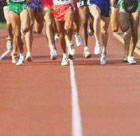| |
Proper Nutrition Helps Athletes Get Stronger
|
|

Although supplements will not necessarily ensure that you will become Mr. or Ms. Universe or will win the Heisman Trophy, you definitely cannot expect to be a winner with an impoverished diet. A supplement program is, therefore, needed to provide an investment against possible deficiencies.
Since athletes consume more oxygen than couch potatoes, they may suffer damage from oxygen-generated free radicals. In fact, reported Elizabeth Somer, M.D., R.D., in The Nutrition Report, researchers speculate that many consequences of exercise, including muscle soreness, tissue energy, increased susceptibility to infection, mood swings, and so forth, might be at least partially a result of free-radical damage to tissues.
She quoted Ian Gillam of Victoria, Australia, as saying that tissue damage, including cell membranes and red blood cells, was lowered 25 percent after intensive exercise when athletes consumed 1,000 mg of vitamin С and 1,000 IU of vitamin E daily. It was suggested that muscles recover more quickly when high levels of these antioxidants are maintained in the tissues.
Lester Packer, Ph.D., and George Brooks, Ph.D., of the University of California at Berkeley, added that supplements may be necessary, because the normal intake of the antioxidants does not seem to raise tissue levels sufficiently to protect against exercise-induced oxidative stress.
Writing in Medicine and Science in Sports and Exercise in 1993, A. Goldfarb reported that, although antioxidants (vitamins А, С, Е, beta carotene and minerals such as selenium) are useful in counteracting free-radical damage, the body may be overloaded to such an extent that the body is partially unprotected from lipid (fat) peroxidation.
In a study of 12 male and 11 female endurance athletes, Michael Colgan, Ph.D., and colleagues reported in The Journal of Applied Nutrition in 1991, that the Recommended Dietary Allowances for many nutrients are insufficient for endurance athletes in intensive training, and that these athletes need supplementary nutrients other than iron to improve hematologic status and endurance performance.
Specifically, they said, the absence of increased blood levels of vitamin В12, folic acid, zinc and vitamin С during periods of supplementation at the level of the RDA and a lack of improvement of the maximum amounts of oxygen that could be used (MV02), and the time to exhaustion during these periods, suggest that the RDAs for these nutrients are insufficient for optimal performance for endurance athletes.
Total cholesterol decreases and the ratio of total cholesterol to high-density lipoprotein cholesterol (the beneficial kind) increases when athletes are supplemented with niacin (B3) and chromium (niacin-bound chromium), according to Robert Lefavi and colleagues in The FASEB Journal in 1991.
In the study, conducted at Auburn University in Alabama and the U.S. Department of Agriculture in Beltsville, Md., male bodybuilders were given either 1.8 mg of niacin and 200 meg of chromium, 7.2 mg of niacin and 800 meg of chromium or a placebo daily. Although Lefavi is with Georgia Southern University in Statesboro, Ga., his research was done at Auburn University.
Following eight weeks of supplementation with niacin-bound chromium (chromium polynicotinate), average blood levels of cholesterol in the group receiving 200 mcg of chromium dropped from 147.9 to 126.8 mg/dl, or a decrease of 14.3 percent. For those in the 800 meg-group, cholesterol went down from 159.2 to 131.3 mg/dl. In the placebo group, cholesterol increased from 139.9 to 153.4 mg/dl.
In the niacin-bound chromium group, total cholesterol to beneficial HDL-cholesterol, which is a risk factor for cardiovascular disease, dropped significantly. But in the non-treated group, this ratio was increased.
Researchers at Western Washington University in Bellingham reported in The Journal of the American College of Nutrition in 1992 that magnesium supplements may enhance strength-training effects.
The study, headed by L. Brilla, determined that the mineral improved muscle torque or rotation production of the quadriceps — the large muscles at the front of the thigh — in relation to both body weight and lean body mass.
The 26 volunteers, ranging in age from 18 to 30, were supplemented with either placebos or magnesium. Total magnesium intake from diet and supplements was equivalent to 545 mg/day for a 150-lb individual.
The mineral seems to improve strength gains during training because of its effect on protein synthesis.
Writing in the Journal of 'Nutrition in 1991, Irene Simon-Schnass, a German researcher, reported that athletes often have a decrease in aerobic threshold when they are climbing at high altitudes. Based on a number of parameters, there was a decreased physical performance in the athletes given a placebo.
However, both the treatment group and those getting a placebo experienced a clear benefit after being given 200 mg twice a day of vitamin E.
Vitamin E was also the subject of a research study in 1992 at the University of Hyderabad in India. During the study, female rats were exercised to exhaustion, which increased the production of free radicals in the heart tissue.
Following vitamin E therapy for two months, the research team concluded that vitamin E supplements protected the animals from the free radical-induced tissue.
At the Milton S. Hershey Medical Center in Hershey, Pa., Tom Lloyd, Ph.D., and colleagues studied 108 premenopausal runners and 34 controls, according to Nutrition Research in 1992. They reported that 80 percent of the runners did not meet the Recommended Dietary Allowances for iron, calcium and zinc.
Following a run or some other endurnace event, athletes often come down with a cold or other respiratory tract infection.
During a three-week study, researchers at the University of Cape Town in South Africa gave 92 marathon runners and matched controls either 600 mg/day of vitamin С or a placebo. The results, as reported in the American Journal of Clinical Nutrition in 1993 showed that, while 68 percent of those getting a placebo came down with an upper respiratory tract infection, only 33 percent getting vitamin С became ill.
|





